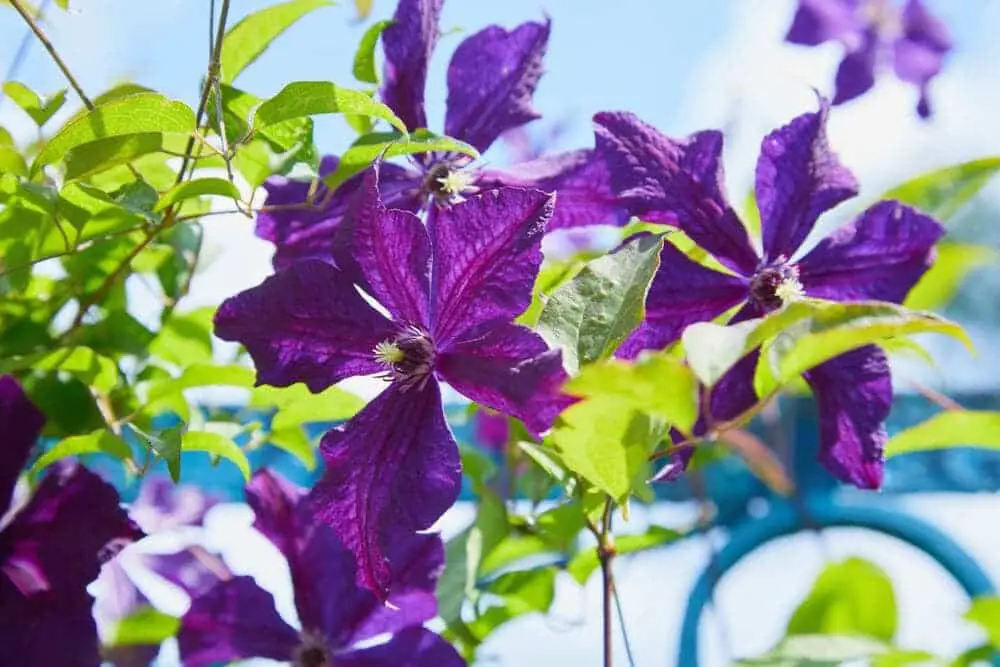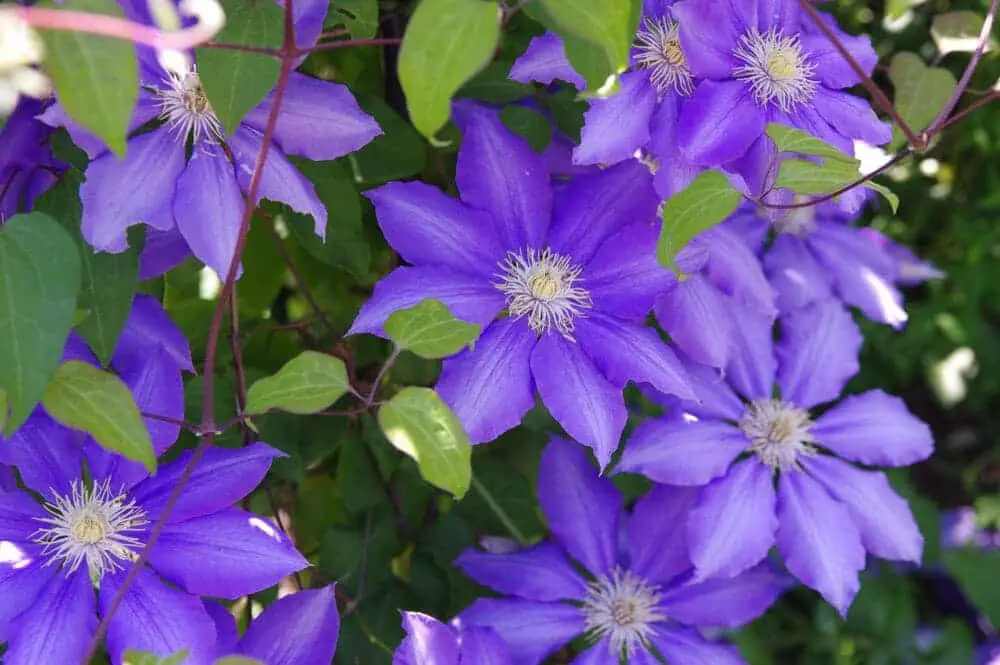If you want to grow a clematis plant, there are some very specific things you will need to know.
This plant will make an excellent part of your home’s landscaping. It will add some nice color to your home’s exterior.
While it can be somewhat high maintenance, it is well worth the effort.
Clematis Care & Growing Guide
1. Light Requirement
If you are planning on growing this plant facing the south, it should be shaded from the afternoon sun. There are many varieties of this plant that can thrive in partial shade. The only way for this plant to produce blooms is in full sunlight, so you’ll need to keep that in mind.
2. Water
The clematis plant cannot survive if it is kept in dry soil for a significant length of time. This means that you will need to keep constantly keep the soil moist. You can simply feel the soil to determine whether or not watering is needed.
It is incredibly important that you water this plant thoroughly, as their roots go deep into the ground. You need to make sure that the soil is adequately moist each time you water it. Make sure to water a bit more than usual throughout dry periods in the summer months.
3. Climate
This plant can be grown in hardiness zones 4 through 9. Some varieties of this plant thrive in hot climates, while others do very well in cooler environments. It all depends on the variety of clematis that you want to grow.
4. Soil
Clematis plants do best in rich soils that offer excellent drainage. You’ll want to choose a soil with a neutral. If you need to increase the acidity a bit, you can always put in some lime. You’ll want to plant the crown of the plant three to four inches beneath the surface of the soil. By doing this you will keep the dormant buds intact.
If you are going to plant your clematis outside, you’ll need to select a spot that is away from other plants. The roots of this plant tend to go deep and spread out wide. You will therefore not want any other plants getting in the way.

5. Temperature
These plants can thrive in very hot temperatures in excessive of 100 degrees Fahrenheit. If you are keeping them outside, temperatures of 45 degrees Fahrenheit or lower will cause them to go dormant.
6. Repotting
When you need to repot your clematis, you’ll have to give it a good long watering the day before. You also need to select the perfect location and have the soil mix. You might need to use a tool to get the plan t out if it is wedged tight in the pot.
Make sure that the container you transfer this plant to is two times larger than the one it is currently in. This plant’s roots spread out quickly and go deep, so you have to keep that in mind. If the plant is rootbound, you’ll need to gently coax the roots from the rootball. This will prevent damage to the root system.
Place the plant into the new container with well-draining, fertile soil. Once you have put the plant into the new pot, water it without a seaweed extract solution. This will encourage growth.
7. Speed of Growth
Clematis grows approximately 18 inches every year, but it depends on the variety. The fact is that certain varieties of this plant grow faster than others.
8. Height and Spread
The clematis plant grows to between 3 to 20 feet tall and up to 20 feet wide, depending on the variety. It is important that you know which variety you are dealing with so you can allot enough space as it matures.
9. Flowers
The beautiful flowers that the clematis plant produces are purple and sometimes white. These flowers can be up to five by five inches in size each.
10. Trimming
When it comes to trimming your clematis plant, you will need to consider the variety. Plants that bloom in early spring need to be trimmed back around June.
If you have a large flowering variety, you’ll need to trim the plant back to its top buds in early spring.
Clematis plants that bloom late need to be trimmed back 2-3 feet by March.

Is the Clematis Plant Poisonous?
This plant is considered to be mildly toxic to humans and pets. You will therefore need to be careful about keeping this plant around small kids or animals.
How to get Clematis Plant to Flower
You’ll want to cut this plant down in half after its primary bloom period has passed. This will encourage flowering in a big way.
Common Clematis Plant Diseases
Leaf spot is one of the biggest concerns when it comes to diseases that affect clematis plants. This presents as black spots on the leaves. It will require you to remove any infected leaves immediately to stop the spread.
There is also “clematis wilt”, which presents as dark brown spots on the leaves. Simply trim off the infected leaves so it doesn’t get any worse.
If you notice the leaves on your plant withering and dying, it might be due to powdery mildew. Just put some cooper sulfate on the plant.
Conclusion
- If you are growing a clematis plant outside, you should keep it in partial shade.
- The soil this plant is in should be kept fairly moist at all times.
- If you notice the plant’s soil is dry, it is time to water it.
- This plant can be grown in hardiness zones 4 through 9. It can survive in very hot regions.
- Make sure that you thoroughly water this plant before repotting it.
- If the plant is rootbound, use a tool to gently separate the roots from the rootball.
- This plant grows around 18 inches per year, though it depends on the variety.
- Clematis plants have beautiful purple flowers that can grow up to five by five inches large.
- Keep an eye out for wilting or dying leaves. This is usually a sign of infection. Simply prune the affected leaves off as soon as possible.
Victoria is the owner and main author of hobby plants. She loves spending her free time in her garden planting and taking care of her plants. Victoria hopes you enjoy the content here!
![Queen Of The Night Flower [Complete Plant Care Guide] Queen Of The Night Flower [Complete Plant Care Guide]](https://www.hobbyplants.com/wp-content/uploads/2022/07/queen-of-the-night-flower-300x158.jpg)
![Mother Of Thousands Plant [Complete Plant Care Guide] Mother Of Thousands Plant [Complete Plant Care Guide]](https://www.hobbyplants.com/wp-content/uploads/2022/07/mother-of-thousands-plant-300x158.jpg)
![How Often Should You Water Pothos? [Complete Care Guide] How Often Should You Water Pothos? [Complete Care Guide]](https://www.hobbyplants.com/wp-content/uploads/2022/07/how-often-to-water-pothos-300x158.jpg)
![Can Snake Plants Live Outside? [COMPLETE CARE GUIDE] Can Snake Plants Live Outside? [COMPLETE CARE GUIDE]](https://www.hobbyplants.com/wp-content/uploads/2022/08/can-snake-plants-live-outside-300x158.jpg)
![Majesty Palm Plant Care: [Complete Beginner's Guide] Majesty Palm Plant Care: [Complete Beginner's Guide]](https://www.hobbyplants.com/wp-content/uploads/2022/08/majesty-palm-care-300x158.jpg)
![Exotic Angel Plant Care: [Complete Beginner's Guide] Exotic Angel Plant Care: [Complete Beginner's Guide]](https://www.hobbyplants.com/wp-content/uploads/2022/08/exotic-angel-plant-care-300x158.jpg)
![Do Coleus Like Sun Or Shade: [Complete Care Guide] Do Coleus Like Sun Or Shade: [Complete Care Guide]](https://www.hobbyplants.com/wp-content/uploads/2022/08/coleus-sun-or-shade-300x158.jpg)
![Snow White Waffle Plant: [Complete Care Guide] Snow White Waffle Plant: [Complete Care Guide]](https://www.hobbyplants.com/wp-content/uploads/2022/08/snow-white-waffle-plant-300x158.jpg)
![Waffle Plant Care: [Complete Beginner's Guide] Waffle Plant Care: [Complete Beginner's Guide]](https://www.hobbyplants.com/wp-content/uploads/2022/08/waffle-plant-300x158.jpg)
![Bird Of Paradise Plant Care: [Complete Beginner's Guide] Bird Of Paradise Plant Care: [Complete Beginner's Guide]](https://www.hobbyplants.com/wp-content/uploads/2022/08/bird-of-paradise-plant-300x158.jpg)
![Purple Passion Plant Care: [Complete Beginner's Guide] Purple Passion Plant Care: [Complete Beginner's Guide]](https://www.hobbyplants.com/wp-content/uploads/2022/08/purple-passion-plant-care-300x158.jpg)
![China Doll Plant Care: [Complete Beginner's Guide] China Doll Plant Care: [Complete Beginner's Guide]](https://www.hobbyplants.com/wp-content/uploads/2022/09/china-doll-plant-care-300x158.jpg)